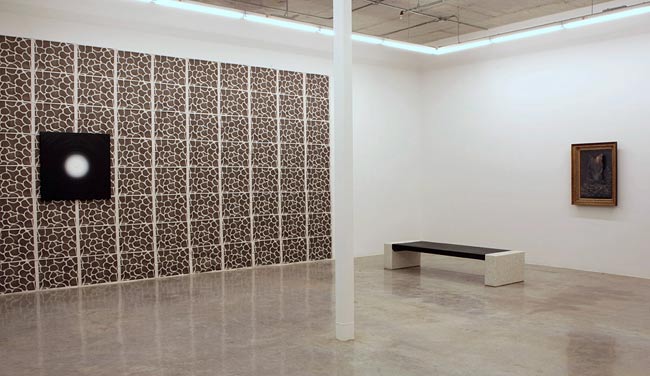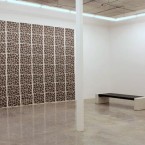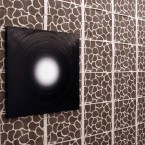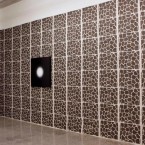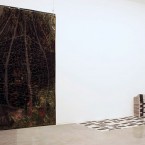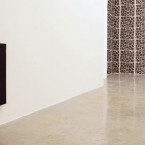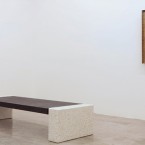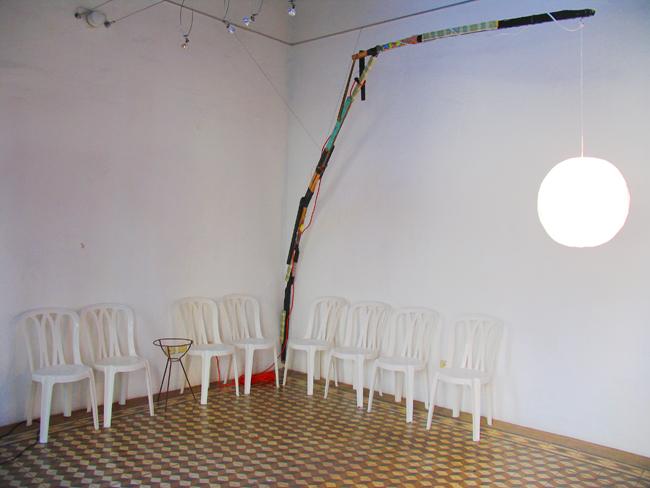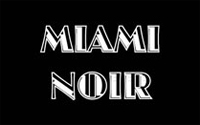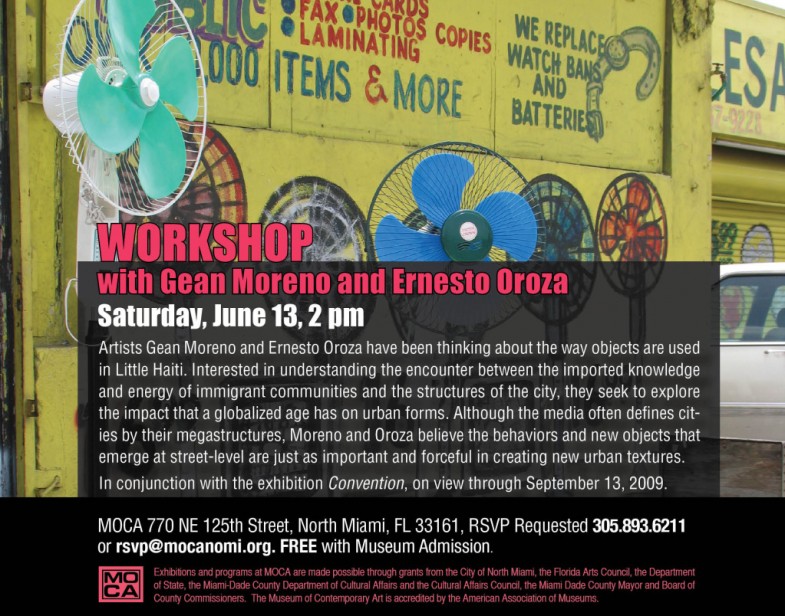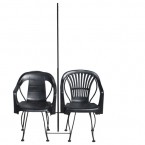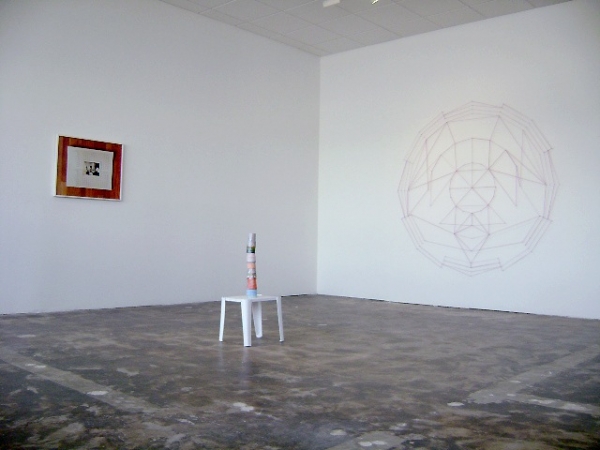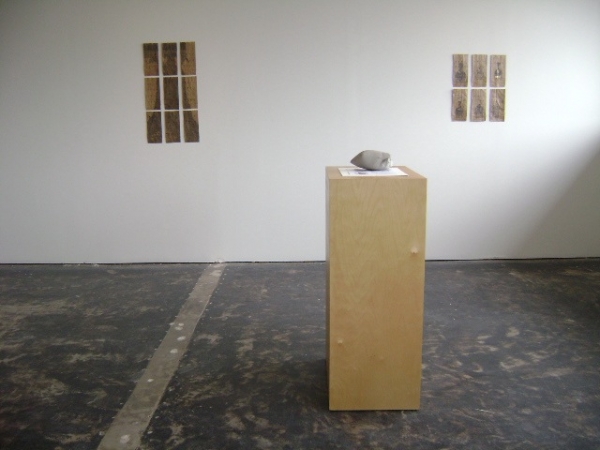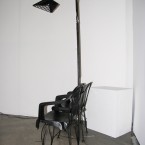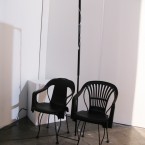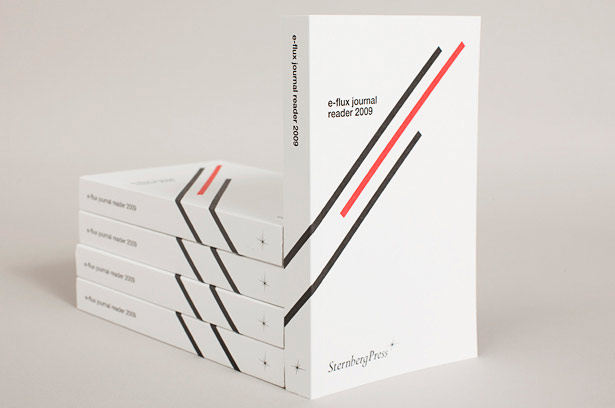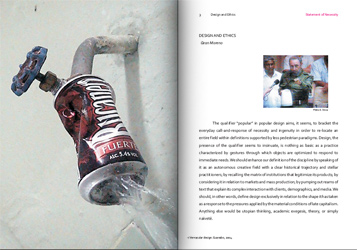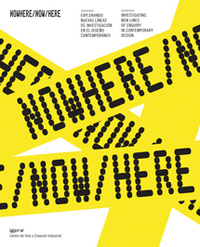Freddy Table. Plywood and buckets. 2009
Dimensions variable.
Bhakti Baxter, Nicolas Lobo, Gean Moreno, Daniel Newman, Ernesto Oroza, and Gavin Perry will be featured in the exhibition, Spit-Polishing a Starless Sky/Outer Space, at Charest-Weinberg Gallery, from September 12 through October 5, 2009. The opening reception will be on September 12 from 6pm to 9 pm at 250 NW 23rd Street, Space 408, Miami, FL 33127.
The exhibition is comprised of two different exhibitions that have been superimposed without any attempt to make them cohere. Two sets of information have simply been brought together, and the resulting form of the exhibition will be determined by the very dynamics of their interaction.
The first exhibition, Spit-Polishing a Starless Sky, is made up of black or nearly-black paintings by Bhakti Baxter, Daniel Newman and Gavin Perry. In the work of all these painters, the black monochrome is entwined with references that belong in cultural spheres that exist far away from formalist concerns. In Baxter’s case, the black paintings double as images of macroscopic phenomena and have a scientific flavor. In Perry’s work, the black monochrome is literally the high-end side of paintings that also trade in lowbrow referents and objects, like cheap rugs and souped up cars. With Newman, the black glaze is all process. He has covered over 200 found paintings with black, turning a gesture characteristic of iconophobia into a delirious flow of production. In a sense, in the work of all these painters, two sets of information are already blended. Each of their works becomes a stand-in for the overall structure of a double-exhibition with incompatible or competing halves.
The second exhibition, Outer Space, titled after a 1999 short film by Peter Tscherkassky, will be made up of sculptural proposals by Nicolas Lobo and Giancarlo Sardone, and Ernesto Oroza and Gean Moreno. Each of these collaborative projects begins with elements provided by the technologies, conventions and infrastructure that form the invisible materiality of our social space. Working through all the engineering problems and ontological recoding that rendering a virtual artifact in actual space brings, Lobo has collaborated with terrazzo mason Sardone to produced a real-life double of a standard bench that can be found ready-made in the design program SketchUp. As the bench took shape, its proportions began to feel slightly off due to some distortion caused the Sketchup rendering engine. What looked like a perfectly bland bench on screen takes on an uncanny air in our physical space. Oroza and Moreno will use the tabloid, of the sort found throughout the city’s neighborhoods, to create both a “catalog” and an ornamental wallpaper pattern from forms determined by the exhibition itself that will, in turn, activate the supposed neutral walls of the space.
All the artists in the exhibition are part of Miami’s burgeoning scene. They have all exhibited their work internationally and are represented in the collections of major museums. This will be the first time their work is shown at Charest-Weinberg Gallery, whose reputation continues to grow as Miami’s premier venue for emerging art.
Ficciones postmodernas en Miami
Domingo, 09.27.09
By ADRIANA HERRERA
Especial/El Nuevo Herald
Charest-Weinberg Gallery es un espacio artístico abierto al riesgo inteligente, a exploraciones tan inusuales en su método como coherentes. Prueba de ello es el montaje de dos muestras paralelas curadas por Gean Moreno y yuxtapuestas en la exhibición Spit-Polishing a Starless Sky/Outer Space. El hecho de que ninguna de las piezas esté identificada –pese a que algunas poseen títulos– obedece a la naturaleza de un proyecto que fusiona la autoría individual y la anónima o colectiva, y también lo decorativo y lo documental; la reproducción virtual y la mecánica; y las estrategias propias del diseño o de la literatura, con el arte. Al explorar en el espacio las intersecciones de las piezas de Daniel Newman, Bhakti Baxter y Gavin Perry –que conforman la primera exhibición, Spit-Polishing a Starless Sky— con las de Gean Moreno, Ernesto Oroza, y Nicolás Lobo -que conforman la segunda, Outer Space— se logra una gran instalación colectiva, que rebasa los límites conceptuales claves.
El catálogo de esta exhibición doble, apilado a la izquierda de la entrada de la galería, evoca las imágenes que Félix González-Torres imprimió en papel periódico, alterando la relación entre las obras y el espectador. Pero aquí estamos ante otras implicaciones. Al desdoblar el catálogo descubrimos dos hojas impresas en tabloide que documentan cada muestra. La pila está colocada sobre una pieza instalada en el suelo y justamente hecha con seis copias extendidas del diagrama de dos cuadrados y un rectángulo duplicados que Oroza y Moreno obtuvieron de la impresión en prensa del oscuro “reverso” de las obras de Baxter, Newman y Perry que conformanSpit-Polishing a Starless Sky. Estas alcanzan a distinguirse por la otra cara de la hoja, aunque son pinturas “negras”, casi monocromáticas. La pintura de Newman forma parte de una serie de cuadros encontrados que “canceló” cubriéndolas casi por completo de negro “en un gesto característico de icono-fobia”, según Moreno. La bella pieza colgante de Perry está hecha sobre una alfombra rectangular común, a la que recubrió de negro. Light Tunnel de Baxter es un foco luminiscente rodeado de “un cielo sin estrellas” –como el título–, construido con trazos circulares negros, que indagan en formas reveladas por la ciencia.
En la segunda hoja del catálogo aparece por una cara del periódico el segundo diagrama de Oroza y Moreno: lo tomaron de una documentación sobre diseños populares realizada en Little Haiti, en Miami: era la fachada de una casa decorada con una simulación de piedras en la calle 79. Al reproducir la imagen a tamaño tabloide en papel se convierte en un patrón geométrico que puede multiplicarse y que usan como matriz de trabajo para producir inquietantes intersecciones. El cruce de diseños traspasado al arte, por ejemplo. Tampoco es azar que en el anverso de esta hoja aparezcan el supuesto prólogo del editor a la última novela de E.T.A. Hoffmann, y el modelo del banco que Nicolás Lobo construyó con Giancarlo Sardone tras tomarlo, como un objeto encontrado, del programa, de Google Earth, que se usa para hacer modelos virtuales arquitectónicos y para otros usos en la red, pero no para construir objetos reales.
Junto al traspaso de ese modelo virtual a un medio mecánico como el papel impreso (y a su real existencia en el espacio interior en la galería), el espectador ve, justo en frente del catálogo apilado, que con la hoja de periódico del patrón de piedras se ha empapelado por completo la pared del fondo y media pared lateral, y que el efecto de la multiplicación es asombroso: esa imagen que documentaba una intervención de decoración popular, funciona ahora como un bello papel de colgadura que duplica su efecto, además, en el espejo de una de las puertas de la galería. Pero no sólo eso: en uno de los lados de la pared empapelada está colgado el Túnel de luz de Baxter, y la impresión es que el diagrama y la pintura forman una sola obra continua. Esa fusión es tan perfecta como transgresora: la instalación sofistica el diseño espontáneo anónimo hasta usarlo como una perfecta decoración de interiores, pero también hace de la piedra papel, vuelve el objeto frágil y perecedero, del mismo modo en que disuelve la noción de autoría. Ese hilo de continuidad que tiene como base los mecanismos de reproducción y la apropiación de diseños prefabricados tanto como la incorporación de piezas que exploran otros modos de cancelación de límites se prolonga en el texto del catálogo. Hoffman, juez de oficio, pero también ilustrador, tenor y autor romántico de los Cuentos fantásticos que encandilaron a Offenbach, quien los llevó a la ópera, compuso en 1919 su extraña novela The Life and Opinions of the Tomcat Murr. Como explica el lúdico prólogo se trata de la autobiografía de un gato, que por descuido editorial, salió impreso sin notar que incorporaba las pilas de hojas de otro libro sobre un compositor, con las cuales el gato Murr jugaba. El “editor” pide disculpas por las yuxtaposiciones –paralelas a los “descuidos” de estas dos muestras fusionadas en los que una obra se incorpora a otra sin que nadie se tome el cuidado de colocar los créditos de identificación precisos–, así como por los juegos de sentido que resultan de determinados errores tipográficos. El texto habla directamente al lector, pidiendo su “discreción” y es auto-reflexivo en torno al proceso editorial, con una humorística ironía que permite introducirse en su estructura impredecible (por su naturaleza felina), y discontinua que la convierte en “una de las primeras ficciones posmodernas”. Resulta semejante en sus osadas mezclas de autores a esta exhibición que funde las pinturas en negro de una muestra, con los desbordamientos de espacios y de usos insólitos de la reproducción de la otra. El juego referencial del catálogo es interminable: Hoffmann se apropiaba, ya desde el título, de la cervantina novela de Lawrence Sterne, The Life and Opinions of Tristam Shandy, que contiene ese mismo libro dentro del libro, asteriscos en vez de ciertas palabras, una página totalmente negra, y la virtud compartida con esta exhibición –tan pulcra en su instalación minimalista que pasaría por decorativa– de expandir los límites mentales. •
adrianaherrerat@aol.com
`Spit-Polishing a Starless Sky/Outer Space’ de Daniel Newman, Bhakti Baxter, Gavin Perry, Gean Moreno, Ernesto Oroza, y Nicolás Lobo en Charest-Weinberg Gallery, 250 NW 23 St., Space 408. Hasta el 5 de octubre.
See exhibition images here
RIKIMBILI. Une étude sur la désobéissance technologique et quelques formes de réinvention. 2009
Ernesto Oroza
(Préfacier) Marie-Haude Caraës
Traducteur: Nicole Marchand-Zanartu
67 p.
format : 165 x 215
ISBN : 978-2-86272-527-7
Publications de l’Université de Saint-Étienne, 2009
Cité du design
BUY
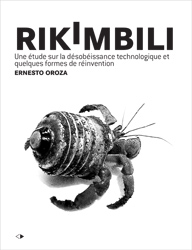
“Quand nous acceptons le critère bourgeois qui sanctionne la nécessité comme indigne et celui qui exprime ses besoins comme faible et vulgaire, nous participons à la réduction systématique de la créativité et de la liberté qui pourrait se traduire dans la culture contemporaine.” Ernesto Oroza
“PLOUGHSHARES AS TECHNOLOGICAL DISOBEDIENCE (CUBA)
Cite du design is a broad church. Whilst hordes of courtiers flocked around the Minister like starlings at sunset, copies of a subversive new book, by Ernesto Oroza, were being distributed by Cite’s publications team. Rikimbili – “a study of technological disobedience and other forms of re-invention” – describes how Cubans have adapted and recycled industrial objects during fifty years of US sanctions. The book’s title, Rikimbili, is named after a two-wheeled vehicle that started its life as a bicycle. The book is subversive because, for me anyway, it describes the kind of design we’ll be doing in the coming age of scarcity industrialism (a phrase of John Michael Greer). Design shows filled with shiny objects, by contrast, are best perceived as historical events about a pardigm that has passed. Write direct to obtain your copy of Rikimbili to: emilie.chabert at citedudesign dot com.”
John Thackara
from: doorsofperception.com
Miami Noir at Invisible Export,NY, Gean Moreno and Ernesto Oroza.
Gean Moreno and Ernesto Oroza’s presentation will extend from their collaboratively written text published in issue six of the E-Flux Journal. Click here for full text
Museum of Contemporary Art | 770 NE 125 Street | North Miami | FL | 33161
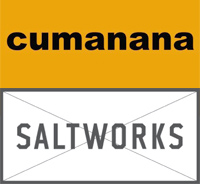
Cumanana / SALTWORKS/ February 13 – April 11, 2009
Group Exhibition / curated by William Cordova
Johanna Almiron, Dawolu Jabari Anderson, Jade Cooper, William Cordova, Nathaniel Donnett, Leslie Hewitt, Gean Moreno, Glexis Novoa, Mari Omori, Ernesto Oroza, Ronny Quevedo, Kaijiro Suzuki, Mary Valverde.
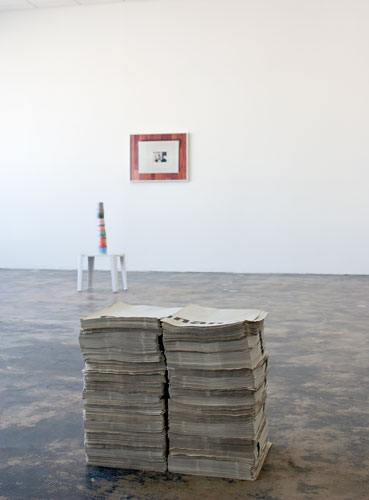
Cumanana, 2009, Installation View
E-flux Journal Reader 2009
Anton Vidokle (Author, Editor), Julieta Aranda (Editor), Brian Kuan Wood (Editor)
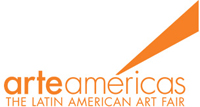
Ernesto Oroza will be represented by Alonso Art.
Also he will participate at Project Room: Large Sculptures, and La Habana Pavilion: Two Visions of Cuba
Visionary Drawing Building
Gean Moreno and Ernesto Oroza.
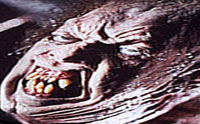
STUDIO SCRAP STOOL at Designboom

More info here
- Ernesto Oroza. Potential house, 2008.
- Ernesto Oroza. Potential house, 2008.
- Ernesto Oroza. Potential house, 2008.
- Book documenting the exhibition Statement of Necessity by Ernesto Oroza, at Alonso Art in November-December, 2008. The book features the 20 color photographs exhibited. www.alonsoart.com
Statement of Necessity by Ernesto Oroza
Foreword: Gean Moreno
Paperback
Publisher: Alonso Art and BookSurge Publishing (November 11, 2008)
ISBN-10: 1439216657
ISBN-13: 978-1439216651
Book documenting the exhibition Statement of Necessity by Ernesto Oroza, at Alonso Art in November-December, 2008. The book features the 20 color photographs exhibited. www.alonsoart.com
DESIGN AND ETHICS
–Gean Moreno
The qualifier “popular” in popular design aims, it seems, to bracket the everyday call-and-response of necessity and ingenuity in order to re-locate an entire field within definitions supported by less pedestrian paradigms. Design, the presence of the qualifier seems to insinuate, is nothing as basic as a practice characterized by gestures through which objects are optimized to respond to immediate needs. We should enhance our definition of the discipline by speaking of it as an autonomous creative field with a clear historical trajectory and stellar practitioners; by recalling the matrix of institutions that legitimize its products; by considering it in relation to markets and mass production; by pumping out reams of text that explain its complex interaction with clients, demographics, and media. We should, in other words, define design exclusively in relation to the shape it has taken as a response to the pressures applied by the material conditions of late capitalism. Anything else would be utopian thinking, academic exegesis, theory, or simply naïveté.
Ernesto Oroza came of age as a designer—and as something other than a designer: a meta-designer, a theoretical designer, an ex-designer (as Marti Giuxé says), an artist—in a context in which the material conditions that have shaped design as the global practice that we know and celebrate didn’t exist. Graduating from Havana’s Instituto Superior de Diseño in 1993, he entered the field at a moment when, due to the fall of the Berlin Wall and the end of Soviet subsidies, Cuba was undergoing its most calamitous economic crisis—the Special Period in Times of Peace. This crisis shut down the production of any new objects on the island and nearly eliminated all imports of non-essential foodstuffs and the like. The lesson of this time, Oroza has argued, is that “Cubans understood that they would have to meet their own needs, as they lived in a country where the State owned all productive capabilities. Urgency placed the individual at the center of the country’s survival.”[1] Scarcity marked the moment. And this opened a gulf between emergent needs and the availability of products that responded to these needs. A broken fan couldn’t be replaced by a new one. The possibility of a one-to-one exchange of objects vanished. As the life of things came to an end, there was nothing to take their place. And so aged and broken objects had to be kept in circulation, readjusted and reconfigured to respond to unexpected demands. A broken phone could serve as the base of a fan; a dinner tray became a TV antennae.
Oroza has devised a number of terms to describe the processes that characterized this period of massive popular design. He has spoken of technological disobedience as a fundamental aspect of it, and he uses the term to highlight the fact that it became a common practice to reroute objects intended to respond to a particular need so that they could respond to a completely different one—one that was not envisioned in the processes of design and production from which it emerged. The phone-as-fan-base and the dinner-tray-as-TV-antennae serve as paradigmatic examples. Rather than user-end empowerment that digital technologies have opened up, what we have here is need trumping intended function. It’s not picking whatever song you want, but using the iPod as a wedge to hold a doorjamb in place. Not selecting the quality of gasoline at the pump, but using the yellow plastic gas tank as a sign for your taxi.
When enough of these “re-formatted” objects begin to appear, enough to significantly change the morphology of a city or a town, it could be said that this popular design has turned into something else: a popular urbanism; a way of irrevocably altering urban texture. In other words, the individual gestures through which objects are synthetically reformatted to respond to emergent needs—that is, the individual gestures of technological disobedience—coalesce into a large collective force that alters the shape of a city. Oroza has called this collectivization and transcendence of individual instances of disobedience familial urbanism. That is, an urbanism that begins with the alterations that take place in each household, responding to the needs of each family. The familial, however, in becoming urbanism is an example of the whole being more than the parts: as urbanism, it becomes a force the effects of which exceed each of the individual instances that comprise it.
For over a decade, Oroza has documented and theorized this new logic of popular design, always looking for precise concepts that express its singularity. The form of design that he has dealt with is often thought of in terms of recycling in the West, but surrendering it too quickly in this kind of discourse occludes one of the things that has been central to Oroza’s project: naming the engine that drives this mode of design, rather than naming its effects. Recycling as such is a process. What has interested Oroza is the root cause: the question of necessity; that is, an understanding of the local material conditions that underscore the emergence of this explosion of popular design. It’s a matter of keeping an eye on the context, on the historical moment. He has said: “Necessity has been stigmatized in Western culture. If you find yourself in need, you are considered weak. If you express demands for these needs to be met, you are considered vulgar. Since the 1990s, Cubans have done violence to this stigma. Each object produced or solution discovered has been a statement of principle.”[2]
Responding to necessity, then, Oroza considers that each of these objects have an ethical dimension: each is, as he says, a statement of principle and freedom, a response against a plummeting in the quality of living conditions, against a disintegrating social fabric, and, lastly, against an eroding urban texture. This is why Oroza refuses to participate in the discussion of Havana as a ruin. Such a discourse takes a sweeping view of the city, focusing on its dilapidated surfaces, and ignoring the ground-level and “hidden” gestures of its inhabitants, the new behaviors and altered objects that optimize their responses to immediate needs, to pressures that emerge from existing and local material conditions. Behind the crumbling buildings of the city, Oroza argues, there is another interior city, or city of interiorities: one of architectural up-datings and object re-designs that speak the truth of their moment and the ethics of their producers.
[1] Moreno, Gean, “Object as Index: Ernesto Oroza in Conversation with Gean Moreno,” Art Papers, May-June, 2008, p.25
[2] Moreno, Ibid., p.25
NOWHERE/NOW/HERE Exhibition: Laboral Centro de Arte. Download catalogue
Curators: Roberto Feo & Rosario Hurtado (El Último Grito), London / Berlin
LABoral Centro de Arte y Creación Industrial presenta Nowhere/Now/Here, una exposición sobre diseño experimental, comisariada por El Último Grito, asociación creativa formada por Roberto Feo y Rosario Hurtado. Con estudio en Berlín y Londres, ambos comisarios se proponen el reto de superar la percepción clásica del diseño para replantearse nuestra relación con el entorno. Al adoptar como punto de partida la perspectiva de que nuestro entorno ha pasado a formar parte de nosotros sin que nosotros formemos parte de él, Nowhere/Now/Here nos anima a considerar el diseño como un componente integral del proceso que conforma el mundo.
Tres temas clave de la exposición nos embarcan en un viaje inspirador a través de las visiones, los enfoques y las reflexiones personales sobre cómo podemos transformar el modo en que vivimos:
Resistencia cultural: replantea la idea de lo que supone la cultura en la actualidad y las numerosas formas de percibirla, lanza una provocación a los sistemas existentes y propone alternativas nuevas en un contexto socioeconómico y religioso. Asimismo, ofrece una oportunidad de descubrir narrativas nuevas en relación con un objeto, además de cambios culturales en la profesión del diseñador.
Exploración psicológica: investiga nuestra forma de entender un objeto a nivel psicológico. Este tema examina cómo nos relacionamos y reaccionamos emocionalmente ante un objeto y cómo dejamos que nos traslade a lugares y momentos distintos.
Intervención material: analiza las herramientas, materiales y tecnologías nuevas que se aplican a los procesos contemporáneos de diseño y fabricación. Además, este apartado aborda la interferencia entre el consumismo y la ecología. Explora también la influencia de la influencia gráfica y espacial en nuestro comportamiento, así como nuestra relación con el espacio y los objetos.
Nowhere/Now/Here presenta más de 60 obras que incluyen desde productos cotidianos, moda o joyas, hasta instalaciones y muestras en directo de diseñadores reconocidos, como Tord Boontje, Jerszy Seymour, Santiago Cirugeda, Dunne&Raby, junto a diseñadores emergentes como Martino Gamper, Paul Cocksedge, Assa Ashuach, Troika, estudiantes y recién licenciados como Raw Edges, Dash Macdonald y Nacho Carbonell, entre otros. Un aspecto esencial para Nowhere/Now/Here es la contribución de cuatro maestros: Ron Arad, Gaetano Pesce, Javier Mariscal y Daniel Weil, quienes contextualizan el trabajo de la joven generación a través de una serie de entrevistas y algunas de sus obras.
El diseñador presenta habitualmente la idea de un mundo personalizado, más funcional y finalmente mejor a través de grupos formulados sobre la noción del contexto no lineal, que no identifica una disciplina, técnica o material común, sino que crea una unidad que se evoca mediante la asociación de ideas. Este viaje conceptual organizado por El Último Grito atraviesa espacios en varios niveles con formas hexagonales diseñados por Patricia Urquiola y Martino Berghinz, así como la visión y la imagen gráfica de Fernando Gutiérrez.
Nowhere/Now/Here ofrece la oportunidad de reflexionar acerca de cómo el diseño y la tecnología pueden cambiar nuestras vidas, nuestros sistemas y nuestro entorno, enfoque que ha mantenido El Último Grito desde el inicio de su labor creativa. Este dúo ha tenido como constante en su trayectoria el alejamiento de las definiciones preconcebidas para investigar nuevas formas de entender el diseño contemporáneo. Roberto Feo y Rosario Hurtado piensan que Nowhere/Now/Here debe ser un primer paso de algo que tendrá continuación. Con su propuesta para LABoral han querido «iniciar un capítulo, en lugar de cerrarlo».
COMISARIOS: Rosario Hurtado y Roberto Feo (El Último Grito), Londres / Berlín
ARTISTAS: 5:5 Designers, AA, Amidov, Assa Ashuach, Bruce Bell, Bryony Birkbeck, Tord Boontje, Marta Botas & Germán R. Blanco, David Bowen, Fernando Brizio, Nacho Carbonell, Daniel Charny & Gabriel Klasmer, Santiago Cirugeda, Carl Clerkin, Paul Cocksedge, Dainippon Type Organization, Óscar Díaz, Dunne & Raby, Daniel Eatock, Olivia Flore Decaris, Tiago Fonseca, Fulguro & Thomas Jomini, Architecture Workshop, Martino Gamper, Martí Guixé, Mathias Hahn, Interaction Research Studio, Onkar Kular, Tithi Kutchamuch, Dash MacDonald, Material Beliefs (Auger-Loizeau, Elio Caccavale, Tobie Kerridge, Susana Soares, Aleksandar Zivanovic, David Muth), Alejandro Mazuelas, Alon Meron, mmmm…, Eelko Moorer, Oscar Narud, NB: Studio, Ernesto Oroza, Marc Owens, Pedrita, Laura Potter, Corinne Quin, Random International, Raw Edges Design Studio, Nic Rysenbry, Jerszy Seymour, Bert Simons, Studio Glithero, Yuri Suzuki, Gregor Timlin, Noam Toran, Manel Torres, Maud Traon, Troika, Pablo Valbuena, Greetje van Helmond, Dominic Wilcox, Nick Williamson, Marei Wollersberger, Zaunka.
DISEÑO DE LA EXPOSICIÓN: Patricia Urquiola & Martino Berghinz
DISEÑO GRÁFICO: Fernando Gutiérrez








